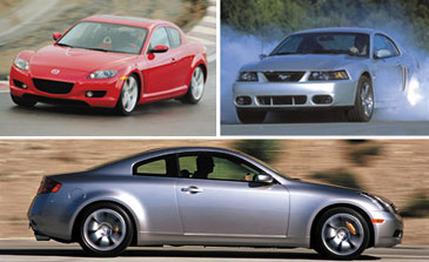
 Comparison Tests
Comparison Tests
The idea of a four-seater that can play boy racer and satisfy its driver as well as any sports car seems like an inherent contradiction. But that is exactly what Mazda has tried to deliver with its brand-new RX-8.
This is a major about-face from Mazda's final RX-7, which garnered passionate praise for its performance, handling, and sporting character. Dedicated to the proposition that anything that didn't bolster its performance was superfluous, the RX-7 was light and tiny, with sheetmetal that seemed to be shrink-wrapped around its mechanical bits and twin seats.
Unfortunately, this intense sporting focus made it supremely impractical, a flaw that was ultimately unsatisfying to the buyers who could afford its lofty price, which was fast approaching $40,000 when it left the U.S. market in 1995. Mazda was determined the RX-8 would not suffer the same shortcomings.
As a result, not only does the RX-8 have plenty of room for its two front-seat occupants, but it also has a pair of rear seats. Moreover, these rear seats are touted as adult-sized and access to them is assisted by a pair of rear-hinged, pickup-style doorlets. No one will be criticizing this particular RX for its practical shortcomings.
That's all well and good, but buyers also expect that any Mazda wearing an RX designation will also be a serious sporting machine. To that end, the RX-8 benefits from an all-new chassis and a major revision of the traditional rotary engine.
The new chassis places great emphasis on rigidity, achieving about twice the bending and torsional stiffness of the last RX-7, thanks to extensive use of computerized design techniques and the reinforcement of the driveline tunnel, effectively turning it into a backbone frame.
Although the front and rear suspensions might sound similar on paper to the old RX-7's, they are actually all-new. In front, each wheel is located by a pair of forged aluminum control arms, which are about 1.3 inches longer than their RX-7 counterparts and provide improved geometry. Gas-pressurized monotube shock absorbers with coil springs and a hollow anti-roll bar control the excursions of this suspension, and the wheels are directed by a steering rack that employs fully electronic power assistance.
At the rear, the RX-8 uses a five-element multilink setup, again with links that are between three and seven inches longer than their equivalents on the RX-7. These links are mounted to a rubber-isolated subframe in a fashion that provides excellent control of wheel camber and minimizes friction in the suspension bushings for improved responsiveness.
Power for this new chassis comes from a massively revised version of the twin-rotor 13B engine, called the Renesis. In the interest of reduced cost, the RX-7 twin turbochargers are gone. However, thanks to a repositioning of the exhaust ports from the periphery of the rotor housing to the side plates, the new engine breathes much easier. As a result, the Renesis develops 250 horsepower at 8500 rpm, almost as much as the 255 developed by the last generation's turbo rotary. Moreover, the Renesis provides improved emissions and fuel economy.
The new engine is also more compact than the old one, allowing it to be placed in the chassis about 1.6 inches lower and 2.4 inches more rearward than the engine in the RX-7. This makes for a front mid-engine design with reduced yaw inertia, which means the car turns more easily. Placing the fuel tank under the rear seat and forward of the rear wheels reinforces this benefit. Yet with a wheelbase of 106.3 inches-10.8 inches longer than the RX-7's-the RX-8 portends excellent straight-line stability.
The car's real promise is sports-car satisfaction combined with genuine four-seat practicality. And the icing on the cake is a bargain window sticker. The base price for the RX-8 is $25,180, although that's for a 210-hp entry-level version with a four-speed automatic. But even the 250-hp, six-speed model starts at only $27,200, and prices barely top $33,000 even if you check every box on the options list.
To judge how well Mazda has achieved its goal of delivering an unbeatable combination of performance, practicality, and price, we put the new RX-8 up against two similarly well-rounded competitors.
The most obvious RX-8 rival is the recently introduced Infiniti G35 coupe. The G35 adds a larger body and rear seat to an elongated version of the chassis used by the outstanding Nissan 350Z. Many of us find the G35 to have a better-proportioned and more graceful profile than the Z's. And with a 280-hp version of Nissan's 3.5-liter V-6, 18-inch wheels and tires, and Brembo brakes, the G35 six-speed coupe is a serious sporting machine.
Even more directly focused toward speed is the Ford SVT Mustang Cobra. This final development of the current Mustang generation, which traces its bloodline to the 1978 Ford Fairmont, is also the best to date, combining a 390-hp supercharged four-cam V-8 with an independent rear suspension. The result is a car that is more refined than we thought possible. Equipped with a functional rear seat, which has always been one of the Mustang's advantages over the late and lamented Camaro, the Cobra combines utility with 12-second quarter-mile times for a reasonable 35 grand.
We devoted three days to identifying the strengths and weaknesses of this exciting trio. We found no losers in this group, but we did identify a winner.